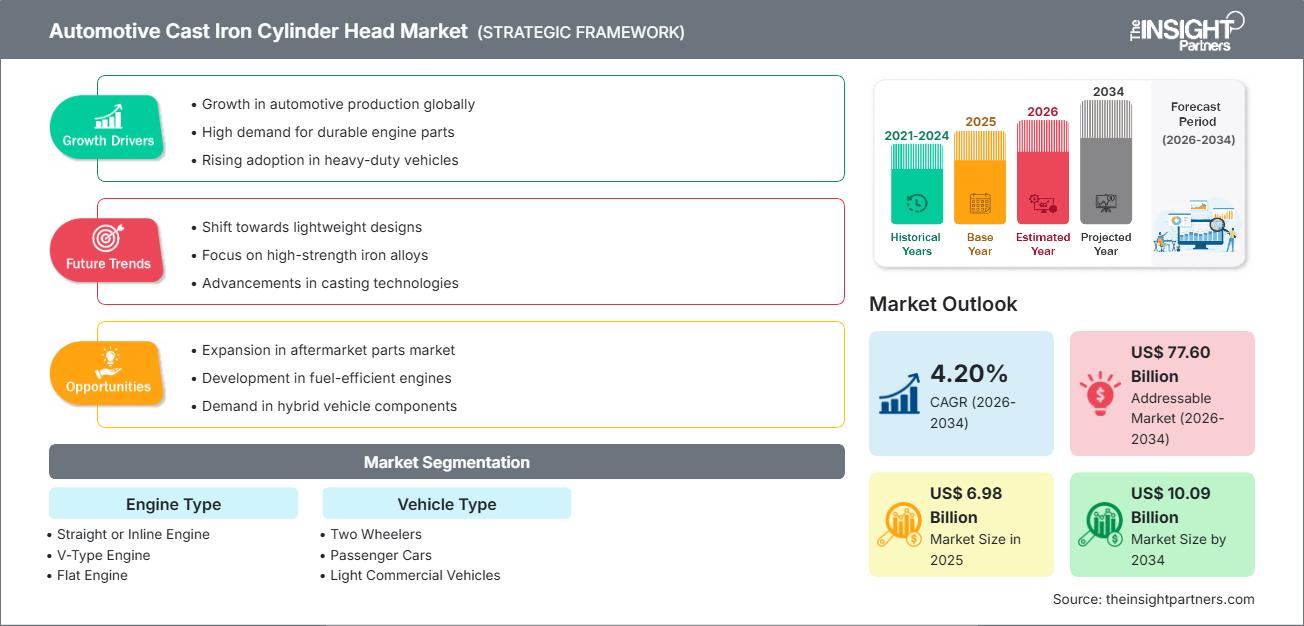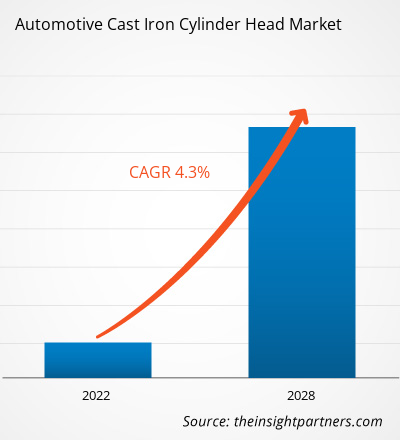Der Markt für Zylinderköpfe aus Gusseisen für die Automobilindustrie wird bis 2034 voraussichtlich ein Volumen von 10,09 Milliarden US-Dollar erreichen, gegenüber 6,98 Milliarden US-Dollar im Jahr 2025. Es wird erwartet, dass der Markt im Zeitraum 2026–2034 eine durchschnittliche jährliche Wachstumsrate (CAGR) von 4,20 % verzeichnen wird.
Marktanalyse für Zylinderköpfe aus Gusseisen im Automobilbereich
Der Markt für Zylinderköpfe aus Gusseisen im Automobilbereich weist eine etablierte und zugleich robuste Struktur auf. Die Nachfrage wird primär von Nutzfahrzeugen und dem Ersatzteilmarkt getragen, wo die hohe Festigkeit, Langlebigkeit und Kosteneffizienz, insbesondere in anspruchsvollen Anwendungen, sehr geschätzt werden. Obwohl die langfristige Entwicklung hin zu Elektrofahrzeugen das Wachstum bremst, liegt der Fokus aktuell auf der Optimierung von Gusseisen für eine sauberere Verbrennung, ein besseres Wärmemanagement und die Erfüllung immer strengerer globaler Emissionsnormen wie BS-VI. Um ein geringeres Gewicht ohne Einbußen bei der Festigkeit zu erzielen, werden fortschrittliche Werkstoffe wie Gusseisen zunehmend eingesetzt.
Marktübersicht für Zylinderköpfe aus Gusseisen im Automobilbereich
Der Zylinderkopf ist ein entscheidendes, hochpräzises Bauteil, das den oberen Teil des Motorblocks abdichtet und die Ventile sowie die Brennräume beherbergt. Zylinderköpfe aus Gusseisen sind die erste Wahl für Motoren, die hohe thermische Stabilität und mechanische Festigkeit erfordern, insbesondere für großvolumige und hochbelastbare Dieselmotoren, die in Lkw, Bussen und Industriemaschinen eingesetzt werden. Dank der hervorragenden Dämpfungseigenschaften und der Kosteneffizienz im Vergleich zu Aluminium ist Gusseisen nach wie vor die Grundlage für die im Nutzfahrzeugbereich erwartete Langlebigkeit und lange Lebensdauer. Hersteller investieren kontinuierlich in verbesserte Gießtechniken und Designoptimierungen, um sicherzustellen, dass Zylinderköpfe aus Gusseisen auch angesichts der Bestrebungen nach höherer Motoreffizienz relevant bleiben.
Passen Sie diesen Bericht Ihren Anforderungen an.
Sie erhalten eine kostenlose Anpassung aller Berichte – einschließlich Teilen dieses Berichts, Länderanalysen und Excel-Datenpaketen – sowie attraktive Angebote und Rabatte für Start-ups und Universitäten.
Markt für Zylinderköpfe aus Gusseisen im Automobilbereich: Strategische Einblicke

-
Ermitteln Sie die wichtigsten Markttrends dieses Berichts.Diese KOSTENLOSE Probe beinhaltet eine Datenanalyse, die von Markttrends bis hin zu Schätzungen und Prognosen reicht.
Markttreiber und Chancen für Zylinderköpfe aus Gusseisen im Automobilsektor
Markttreiber:
- Wachsende Nachfrage nach Aftermarket-Services: Die große weltweite Flotte älterer Fahrzeuge mit Verbrennungsmotor, insbesondere Nutzfahrzeuge, erzeugt eine zuverlässige und hohe Nachfrage nach langlebigen Zylinderköpfen aus Gusseisen für Reparatur und Wartung.
- Überlegene Haltbarkeit und Wärmebeständigkeit: Die hohe Wärmekapazität und Verschleißfestigkeit von Gusseisen machen es unverzichtbar für Hochleistungsmotoren, die unter extremen Belastungen und Temperaturen arbeiten.
- Steigende Fahrzeugproduktionsraten: Die stetige und zunehmende Produktion von Nutzfahrzeugen, insbesondere in Schwellenländern, treibt die Kernnachfrage der Erstausrüster nach Gusseisenkomponenten an.
Marktchancen:
- Entwicklung von leichten Gusseisenalternativen: Die Verwendung neuer Werkstoffe wie Kompaktgraphitguss (CGI) und duktiles Gusseisen bietet eine Möglichkeit zur Herstellung leichterer Zylinderköpfe bei gleichzeitiger Beibehaltung der Festigkeit und Minimierung des Drucks durch Aluminiumlegierungen.
- Fortschrittliche Fertigungsprozesse: Nutzung von Verarbeitungstechnologien wie dem 3D-Kerndruck für Prototypen und anderen Gussverbesserungen zur Bildung komplexerer Kühlkanäle und Optimierung der Metallverteilung für eine verbesserte thermodynamische Leistung.
- Expansion in Schwellenländern: Wachstumsstarke Märkte wie der asiatisch-pazifische Raum (APAC) und Süd- und Mittelamerika (SAM) mit steigendem Fahrzeugbesitz und zunehmender Industrialisierung bieten bedeutende Möglichkeiten für eine Produktions- und Vertriebserweiterung.
Marktbericht: Segmentierungsanalyse für Zylinderköpfe aus Gusseisen für die Automobilindustrie
Der Marktanteil von Zylinderköpfen aus Gusseisen für die Automobilindustrie wird in verschiedenen Segmenten analysiert, um ein besseres Verständnis seiner Struktur, seines Wachstumspotenzials und der sich abzeichnenden Trends zu ermöglichen. Nachfolgend ist der in den meisten Branchenberichten verwendete Standard-Segmentierungsansatz dargestellt:
Nach Motortyp:
- Reihenmotor
- V-Motor
- Flachmotor
Nach Fahrzeugtyp:
- Zweiräder
- Personenkraftwagen
- Leichte Nutzfahrzeuge
- Schwere Nutzfahrzeuge
Nach Geographie:
- Nordamerika
- Europa
- Asien-Pazifik
- Süd- und Mittelamerika
- Naher Osten und Afrika
Regionale Einblicke in den Markt für Zylinderköpfe aus Gusseisen für die Automobilindustrie
Die regionalen Trends und Einflussfaktoren auf den Markt für Zylinderköpfe aus Gusseisen für die Automobilindustrie im gesamten Prognosezeitraum wurden von den Analysten von The Insight Partners eingehend erläutert. Dieser Abschnitt behandelt außerdem die Marktsegmente und die geografische Verteilung des Marktes für Zylinderköpfe aus Gusseisen in Nordamerika, Europa, dem asiatisch-pazifischen Raum, dem Nahen Osten und Afrika sowie Süd- und Mittelamerika.
Marktberichtsumfang für Zylinderköpfe aus Gusseisen im Automobilbereich
| Berichtattribute | Details |
|---|---|
| Marktgröße im Jahr 2025 | 6,98 Milliarden US-Dollar |
| Marktgröße bis 2034 | 10,09 Milliarden US-Dollar |
| Globale durchschnittliche jährliche Wachstumsrate (2026 - 2034) | 4,20 % |
| Historische Daten | 2021-2024 |
| Prognosezeitraum | 2026–2034 |
| Abgedeckte Segmente |
Nach Motortyp
|
| Abgedeckte Regionen und Länder |
Nordamerika
|
| Marktführer und wichtige Unternehmensprofile |
|
Marktdichte der Akteure im Automobil-Zylinderkopf-Gusseisenmarkt: Auswirkungen auf die Geschäftsdynamik verstehen
Der Markt für Zylinderköpfe aus Gusseisen für Automobile wächst rasant, angetrieben durch die steigende Nachfrage der Endverbraucher. Gründe hierfür sind unter anderem sich wandelnde Verbraucherpräferenzen, technologische Fortschritte und ein wachsendes Bewusstsein für die Vorteile des Produkts. Mit steigender Nachfrage erweitern Unternehmen ihr Angebot, entwickeln innovative Lösungen, um den Kundenbedürfnissen gerecht zu werden, und nutzen neue Trends, was das Marktwachstum zusätzlich beflügelt.

- Überblick über die wichtigsten Akteure auf dem Markt für Zylinderköpfe aus Gusseisen für die Automobilindustrie
Marktanteilsanalyse für Zylinderköpfe aus Gusseisen im Automobilsektor nach Regionen
Es wird erwartet, dass sich die Region Asien-Pazifik zum größten und am schnellsten wachsenden Markt für Zylinderköpfe aus Gusseisen für die Automobilindustrie entwickeln wird, angetrieben durch hohe Produktionsvolumina in der Automobilindustrie und eine rasch wachsende Mittelschicht in Ländern wie China und Indien.
Der Markt für Zylinderköpfe aus Gusseisen im Automobilbereich weist aufgrund von Faktoren wie Fahrzeugproduktionsraten, lokaler Nachfrage nach Nutzfahrzeugen im Vergleich zu Personenkraftwagen und der Strenge der Emissionsvorschriften in den einzelnen Regionen unterschiedliche Wachstumsverläufe auf. Nachfolgend finden Sie eine Zusammenfassung der Marktanteile und Trends nach Regionen:
Nordamerika
- Marktanteil: Besitzt einen bedeutenden Marktanteil, der durch die Nachfrage nach schweren Nutzfahrzeugen getrieben wird.
-
Wichtigste Einflussfaktoren:
- Hohe Akzeptanzrate in den Segmenten Schwerlast- und Verteidigungsfahrzeuge.
- Starke Nachfrage nach Hochleistungs- und Ersatzteilen im Aftermarket.
- Trends: Zunehmendes Wachstum, getrieben durch den Einsatz fortschrittlicher Eisenlegierungen wie Gusseisen mit Kompaktgraphit (CGI) in Motoren für schwere Nutzfahrzeuge.
Asien-Pazifik
- Marktanteil: Der größte regionale Markt und der am schnellsten wachsende Markt dürfte durch die massive Automobilproduktion angetrieben werden.
-
Wichtigste Einflussfaktoren:
- Hohes Produktionsvolumen von Fahrzeugen, insbesondere in China und Indien.
- Zunehmender Fahrzeugbesitz aufgrund einer rasch wachsenden Mittelschicht.
- Hohe Nachfrage nach schweren Nutzfahrzeugen, die aufgrund ihrer Langlebigkeit häufig Zylinderköpfe aus Gusseisen verwenden.
- Trends: Kombination aus fortschrittlichen Fertigungsprozessen und Schwerpunkt auf kosteneffizienter Massenproduktion
Europa
- Marktanteil: Großer Markt, was auf besonders strenge Emissionsvorschriften und einige innovative Fortschritte im Motorenbau zurückzuführen ist.
-
Wichtigste Einflussfaktoren:
- Anhaltende Nachfrage aus dem starken Nutzfahrzeugsektor der Region.
- Fokus auf strenge Umweltauflagen als Motor für Innovationen bei der Materialeffizienz.
- Trends: Der Übergang zu effizienteren Konstruktionen und eine wachsende Vorliebe für Aluminium bei Pkw; Gusseisen spielt jedoch weiterhin eine wichtige Rolle bei Anwendungen mit hoher Beanspruchung.
Süd- und Mittelamerika
- Marktanteil: Aufstrebender Markt mit zunehmender Akzeptanz, angetrieben durch regionale Fertigung.
-
Wichtigste Einflussfaktoren:
- Zunehmende Nutzung von digitalem Marketing in den Bereichen E-Commerce und Unterhaltung
- Zunehmende Verfügbarkeit erschwinglicher, cloudbasierter KI-Lösungen von globalen Technologieunternehmen.
- schrittweise Modernisierung der digitalen Infrastruktur, die Social-Analytics-Plattformen unterstützt
- Trends: Die Entwicklung mehrsprachiger automatisierter Übersetzungstools, prädiktiver KI zur Kampagnenoptimierung und Social-Listening-Plattformen.
Naher Osten und Afrika
- Marktanteil: Aufstrebender Markt mit starkem Wachstumspotenzial, angetrieben von den VAE, Saudi-Arabien und Südafrika durch ihre Initiativen zur digitalen Transformation.
-
Wichtigste Einflussfaktoren:
- Wichtige nationale Digital- und KI-Strategien zur Förderung von Innovationen im Bereich des sozialen Engagements.
- Zunehmende Integration von KI-Chatbots und Community-Management-Systemen
- Trends: KI-gestütztes Tracking der Publikumsstimmung, Aufdeckung von Influencer-Betrug und mehrsprachige Inhaltsmoderation durch maschinelles Lernen.
Marktdichte der Akteure im Automobil-Zylinderkopf-Gusseisenmarkt: Auswirkungen auf die Geschäftsdynamik verstehen
Der Markt für Zylinderköpfe aus Gusseisen für die Automobilindustrie ist hart umkämpft und umfasst große globale Gießereispezialisten, integrierte Motorenhersteller und regionale Anbieter. Im Mittelpunkt des Wettbewerbs stehen Materialinnovationen (wie z. B. CGI), Kostenführerschaft und eine zuverlässige Lieferkette, um die wichtigen Erstausrüster (OEM) und den lukrativen Ersatzteilmarkt zu bedienen.
Der Wettbewerb zwingt die Anbieter dazu, sich durch Folgendes zu differenzieren:
- Die Unternehmen differenzieren sich durch hochpräzise Gussverfahren, die komplexe Kühlkanäle ermöglichen, und durch eine optimierte Wandstärke zur Gewichtsreduzierung, ohne die Festigkeit zu beeinträchtigen.
- Der Fokus liegt auf der Steigerung der Effizienz durch Automatisierung (Robotisierung) in Gießereien, um die Zykluszeiten zu verkürzen und die Produktkonsistenz zu gewährleisten.
Chancen und strategische Schritte
- Integriertes Design für das Wärmemanagement: Entwicklung von Zylinderköpfen mit optimierter Innengeometrie zur Verbesserung der Kühlung, was sich direkt auf die Motorleistung und die Einhaltung der Emissionsnormen auswirkt.
- Aftermarket-Fokus: Nutzung der wachsenden Nachfrage nach wiederaufbereiteten oder generalüberholten Zylinderköpfen, um kostengünstige und umweltfreundliche Alternativen zu neuen Komponenten anzubieten.
- Fusionen und Übernahmen sowie Kapazitätserweiterungen: Führende Gießereien tätigen strategische Akquisitionen oder erweitern ihre Produktionskapazitäten (insbesondere im asiatisch-pazifischen Raum), um sich langfristige OEM-Verträge und den Zugang zu regionalen Märkten zu sichern.
Die wichtigsten Unternehmen, die auf dem Markt für Zylinderköpfe aus Gusseisen für die Automobilindustrie tätig sind, sind:
- TOYOTA INDUSTRIES CORPORATION
- Yamaha Motor Co., Ltd.
- Cummins Inc.
- Sandvik Coromant
- YASUNAGA CORPORATION
- NEMAK
- Silbitz Group GmbH
- Mauss GmbH
- TEKSID SPA
Hinweis: Die oben aufgeführten Unternehmen sind nicht in einer bestimmten Reihenfolge geordnet.
Neuigkeiten und aktuelle Entwicklungen auf dem Markt für Zylinderköpfe aus Gusseisen für die Automobilindustrie
- Im Februar 2024 begann Clessie Cummins mit der Erforschung des Potenzials von Dieselmotoren für Pkw. Clessie Cummins ist bekannt für die Verbesserung bestehender Dieselmotoren, die Entwicklung neuer Dieselmotorenkonstruktionen und das Aufstellen von Weltrekorden in puncto Ausdauer und Geschwindigkeit bei Lkw, Bussen und Rennwagen.
Marktbericht: Abdeckung und Ergebnisse des Berichts zum Automobil-Zylinderkopf aus Gusseisen
Der Bericht „Marktgröße und Prognose für Zylinderköpfe aus Gusseisen im Automobilbereich (2021–2034)“ bietet eine detaillierte Analyse des Marktes und deckt folgende Bereiche ab:
- Marktgröße und Prognose für den Automobil-Zylinderkopf aus Gusseisen auf globaler, regionaler und Länderebene für alle wichtigen Marktsegmente, die im Rahmen des Berichts abgedeckt werden
- Markttrends für Zylinderköpfe aus Gusseisen im Automobilsektor sowie Marktdynamiken wie Treiber, Hemmnisse und wichtige Chancen
- Detaillierte PEST- und SWOT-Analyse
- Marktanalyse für Zylinderköpfe aus Gusseisen im Automobilsektor: Wichtige Markttrends, globale und regionale Rahmenbedingungen, Hauptakteure, regulatorische Rahmenbedingungen und aktuelle Marktentwicklungen
- Branchenlandschaft und Wettbewerbsanalyse mit Fokus auf Marktkonzentration, Heatmap-Analyse, führende Akteure und aktuelle Entwicklungen im Markt für Zylinderköpfe aus Gusseisen für die Automobilindustrie. Detaillierte Unternehmensprofile.
- Historische Analyse (2 Jahre), Basisjahr, Prognose (7 Jahre) mit CAGR
- PEST- und SWOT-Analyse
- Marktgröße Wert/Volumen – Global, Regional, Land
- Branchen- und Wettbewerbslandschaft
- Excel-Datensatz
Erfahrungsberichte
Grund zum Kauf
- Fundierte Entscheidungsfindung
- Marktdynamik verstehen
- Wettbewerbsanalyse
- Kundeneinblicke
- Marktprognosen
- Risikominimierung
- Strategische Planung
- Investitionsbegründung
- Identifizierung neuer Märkte
- Verbesserung von Marketingstrategien
- Steigerung der Betriebseffizienz
- Anpassung an regulatorische Trends






















 Kostenlose Probe anfordern für - Markt für Zylinderköpfe aus Gusseisen im Automobilbereich
Kostenlose Probe anfordern für - Markt für Zylinderköpfe aus Gusseisen im Automobilbereich